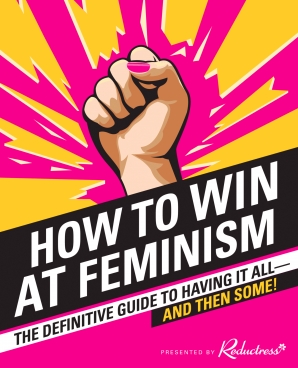50 Book Challenge
This year, I decided I’d do the 50 Book Challenge. This is a wake up call for those who think they read a lot until they physically keep track of it and realize they’re not-so-impressive. I thought I read books left and right, but damn do I feel inferior now. After deciding to do this, I checked and realized I’d only read eight books to date. Pathetic. This challenge probably won’t end well…
Here’s a list of the books I’ve read this year in the unattainable hopes of succeeding at the challenge.
- How to Win at Feminism by Reductress

A book made entirely out of sarcasm is a book I’ll enjoy. Basically, the website Reductress has written a book that makes fun of the weak form of feminism that seems to be prevailing in certain areas. I’m talking about the kind that gets abused by companies to sell products, or by celebrities to gain popularity. I think I’ve heard it referred to as “bubblegum feminism”. Reductress tears this perversion of an important movement into pieces, letting everyone know that actions speak louder than words.
- Scandalous Women by Elizabeth Mahon

I’ve already reviewed this book, but in summary it is definitely a delightful read. Though it focuses too much on white society women who were only scandalous when judged against their lovers, Mahon includes a lot of stories about some very interesting women. Worth a read, but perhaps more to spark your own research into the topic.
- Hausfrau by Jill Essbaum

Hausfrau is reminiscent of Anna Karenina, but just different enough to warrant a reading all its own. Set in present-day Switzerland, the protagonist feels completely isolated as an American expatriate living in a country where she knows nobody but her husband and doesn’t understand the language. She has multiple affairs while her husband works at a Swiss bank, leaving her empty and desperate for something to bring excitement and wonder to her life. Meaning. Being inside her head is a thought-provoking experience. She is a complex, multi-faceted character who feels the anxiety and boredom of her life intensely. Essbaum manages to do what many writers have tried and failed to do, in my opinion: keep the reader engaged while describing listlessness and frustration with daily life.
- The Bean Trees by Barbara Kingsolver

Originally, I borrowed The Poisonwood Bible from the library by this author. It’s her best-known book and was already on my To- Read list, but I was going back to school before I could even pick it up. A friend, however, let me borrow The Bean Trees and I tore through it during my week before classes. It was a great savior from mind-numbing boredom and talking to myself. Its ideas about family and responsibility are lovely. Taylor is at a diner in the middle of escaping her dead-end town when a Native American woman places a baby in her front seat and leaves. From that moment on, Taylor is a mother to the kid, going through all the struggles of having a child without any documentation. Published in 1989, the events have, I think, only managed to become more relevant.
- Pachinko by Min Jin Lee

To sum up quickly (I wrote a review of this some weeks ago), Pachinko is a generational story about a Korean family displaced in Japan. They go through poverty, discrimination, and intense loss and somehow manage to hold themselves together. This book was just superb, and I’d highly suggest reading it. I just don’t know what more I can say about this great addition to literature at this point without sounding like a broken record.
- Milk and Honey by Rupi Kaur

Kaur originally found fame on Tumblr, but she is definitely talented. Her debut book of poetry has four parts, each chronicling the stages of a doomed relationship. If you’re going through a breakup or have been recovering from one, as I was when I read this, Milk and Honey feels like someone finally understands the pain of heartbreak and puts it into the words you’ve been desperately trying to find. It’s simplistic and meaningful without being emotionally manipulative, with illustrations that hit you right in the heart.
7/8. Beloved and The Bluest Eye by Toni Morrison


These were books I’d heard so much about and was desperate to read for quite some time. She’s a prolific author, and stories like Beloved and The Bluest Eye refuse to shy away from incredibly difficult topics. These books make you uncomfortable while giving a rarely acknowledged perspective on slavery and racism in America. Morrison is another writer with a simplistic, honest style that makes the reader feel every word. These were a privilege to read, and I’ll be reading more of Morrison in the future.





